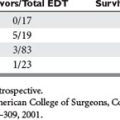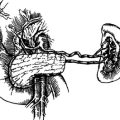CHAPTER 62 VASCULAR ANATOMY OF THE EXTREMITIES
Extremity vascular injuries date as far back as the Greek and Roman civilization. Much of the knowledge regarding vascular trauma and the management of these injuries was gained from military conflicts. DeBakey and Simeone reported the amputation rate to be as high as 40% in World War II, when it was the main life-saving measure for soldiers who sustained extremity injuries. With the advance in surgical technologies and techniques, the rate of amputation dropped to as low as 15% during the Korean War. All this information provides modern surgeons with the ability to manage vascular trauma without the need to enter a combat zone.
DIAGNOSIS
There are hard and soft clinical signs of vascular trauma. The hard signs include the following:
MANAGEMENT
Successful management of extremity vascular injury includes the following components:
VASCULAR ANATOMY OF UPPER EXTREMITY
Axillary Artery
Anteriorly, the axillary artery follows a course under the pectoralis minor muscle as it inserts into the coracoid process. The muscle divides the artery into three anatomical portions:
Brachial Artery
The artery is closely accompanied by a pair of venae comitantes that drain into the axillary vein.
VASCULAR ANATOMY OF LOWER EXTREMITY
Superficial Femoral Artery
This is usually the larger of the two terminating branches. It exits the femoral triangle at the apex and descends into the adductor canal. This canal is bordered by the sartorius muscle medially, vastus medialis anterolaterally, and the adductor longus and magnus muscles posteriorly. Within the canal, the artery is bound closely to the femoral vein by connective tissue. The saphenous nerve lies anterior to the vessel. The artery then pierces the adductor magnus at the adductor hiatus to become the popliteal artery. Near its termination, the superior geniculate artery branches from the femoral artery.
Peroneal Artery
The peroneal artery descends laterally toward the fibula after branching off from the tibioperoneal trunk. It then follows the medial edge of the fibula, between flexor hallucis longus and tibialis posterior muscles, in close relation to the posterior aspect of the fibula and the interosseous membrane throughout the course. At the ankle, the artery gives off a branch that perforates the interosseous membrane. This anterior malleolar branch of the peroneal artery descends in front of the lateral malleolus, and forms an anastomotic network around the malleolus with the lateral and posterior malleolar branches of the peroneal artery. A pair of deep veins accompanies the artery, but there is no major nerve that travels with the artery.
Lumley JSP. Color Atlas of Vascular Surgery. Baltimore: Williams & Wilkins, 1986.
Nyhus LM, Baker RJ, Fischer JE, editors. Master of Surgery. Boston: Little, Brown, 1997.
Rutherford RB, editor. Vascular Surgery, 3rd ed., Philadelphia: Saunders, 1989.
Stoney RJ, Effene DJ. Comprehensive Vascular Exposures. Philadelphia: Lippincott-Raven, 1998.
Zollinger RMJr, Zollinger R. Atlas of Surgical Operations. New York: McGraw-Hill, 1993.







